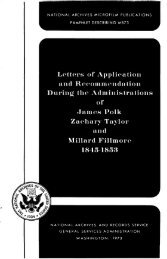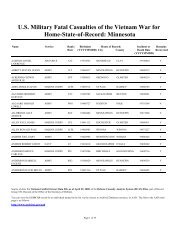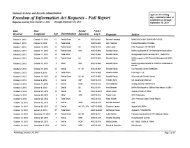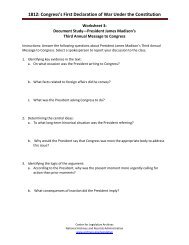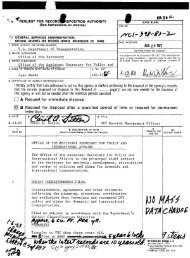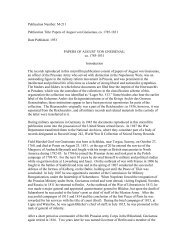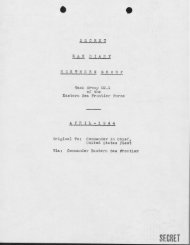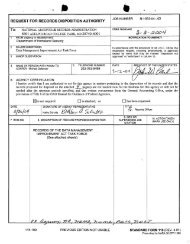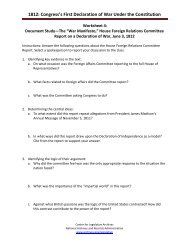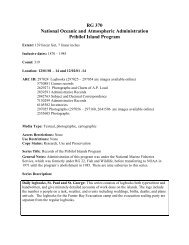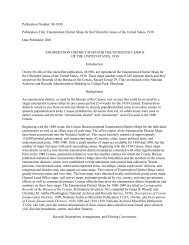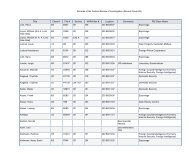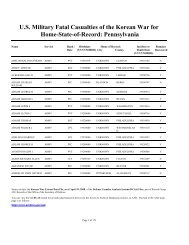HITLER'S SHADOW - National Archives and Records Administration
HITLER'S SHADOW - National Archives and Records Administration
HITLER'S SHADOW - National Archives and Records Administration
You also want an ePaper? Increase the reach of your titles
YUMPU automatically turns print PDFs into web optimized ePapers that Google loves.
of penetrating MVD <strong>and</strong> Polish intelligence units.” 40 “Don’t you think,” said<br />
one CIC memo, “that this is a H[ell] of a good opportunity to recruit some<br />
high class informants?” 41<br />
In November 1947 the Soviet military authorities in Berlin insisted that<br />
UPA members in the U.S. zone be h<strong>and</strong>ed over. “Almost all of them, said Lt.<br />
Col. Igor Bantsyrev (the Chief Soviet Repatriation Representative), “are Soviet<br />
citizens who participated in the war … against the Allied nations on the side of<br />
the German fascist Army.” 42 CIC officers recommended against it. Extradition<br />
of the UPA partisans, said one, could “destroy for years the confidence all anti-<br />
Bolshevist forces have in the USA.” 43<br />
The Soviets learned that B<strong>and</strong>era was in the U.S. zone <strong>and</strong> dem<strong>and</strong>ed his<br />
arrest. A covert Soviet team even entered the U.S. zone in June 1946 to kidnap<br />
B<strong>and</strong>era. 44 The Strategic Services Unit, the postwar successor to the OSS <strong>and</strong><br />
predecessor to the CIA, did not know about the Soviet team. Nonetheless, they<br />
feared the “serious effects on Soviet-American relations likely to ensue from<br />
open US connivance in the unhampered continuance of [B<strong>and</strong>era’s] anti-Soviet<br />
activities on German soil.” 45 Since B<strong>and</strong>era himself was not trustworthy, they<br />
were just as pleased to get rid of him.<br />
Despite “an extensive <strong>and</strong> aggressive search” in mid-1947 that included<br />
regular weekly updates, CIC officials could not locate B<strong>and</strong>era. 46 Few photos<br />
of him existed. One CIC agent complained that B<strong>and</strong>era’s agents in Germany<br />
“have been instructed to disseminate false information concerning the personal<br />
description of B<strong>and</strong>era.” 47 B<strong>and</strong>era’s agents misled CIC as to his location as well.<br />
“Aware of our desire to locate B<strong>and</strong>era,” read one report, “[they] deliberately<br />
attempt to ‘throw us off the track’ by giving out false leads.” 48 CIC suspended<br />
the search. Zsolt Aradi, a Hungarian-born journalist with high Vatican contacts<br />
<strong>and</strong> the chief contact at the Vatican for the Strategic Services Unit (SSU),<br />
warned that B<strong>and</strong>era’s h<strong>and</strong>over to the Soviets would destroy any relationship<br />
with the UHVR, which at the time was headed by B<strong>and</strong>erist members, <strong>and</strong><br />
with Ukrainian clerics at the Vatican like Buczko, who were sympathetic to<br />
B<strong>and</strong>era. 49<br />
The CIA never considered entering into an alliance with B<strong>and</strong>era to procure<br />
intelligence from Ukraine. “By nature,” read a CIA report, “[B<strong>and</strong>era] is a<br />
political intransigent of great personal ambition, who [has] since April 1948,<br />
80 | Collaborators



